Reactivity of glass-embedded met hemoglobin derivatives toward external NO: implications for nitrite-mediated production of bioactive NO
- PMID: 19663497
- PMCID: PMC2743724
- DOI: 10.1021/ja903364h
Reactivity of glass-embedded met hemoglobin derivatives toward external NO: implications for nitrite-mediated production of bioactive NO
Abstract
Many protein reactions are exceedingly difficult to dissect under standard conditions due to low concentrations of reactants and intermediates. A case in point are several proposed reactions of hemoglobin with both nitrite and nitric oxide. In the present work, glassy matrices are used to dynamically control the rate at which externally introduced gaseous NO accesses and reacts with several different met Hb derivatives including the nitrite, nitrate, and aquomet forms. This novel yet general approach reveals a clear difference between nitrite and other ligands including nitrate, water, and an internal imidazole. For nitrate, water, and the internal distal imidazole, the observed spectral changes indicate that NO entering the distal heme pocket is effective in displacing these ligands from the ferric heme iron. In contrast, when the ligand is nitrite, the resulting initial spectra indicate the formation of an intermediate that has distinctly ferrous-like properties. The spectrum and the response of DAF fluorescence to the presence of the intermediate are consistent with a recently proposed nitrite anhydrase reaction. This proposed intermediate is especially significant in that it represents a pathway for a nitrite-dependent catalytic process whereby Hb generates relatively long-lived bioactive forms of NO such as S-nitrosoglutathione. The failure to form this intermediate either at low pH or when the glass is extensively dried is consistent with the requirement for a specific conformation of reactants and residue side chains within the distal heme pocket.
Figures
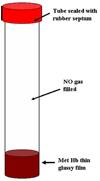

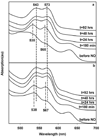
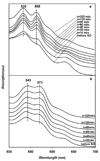
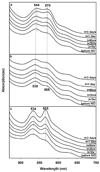
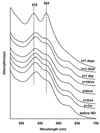
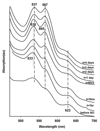

References
-
- Kim-Shapiro DB, Schechter AN, Gladwin MT. Arterioscler Thromb Vasc Biol. 2006;26:697–705. - PubMed
-
- Basu S, Grubina R, Huang J, Conradie J, Huang Z, Jeffers A, Jiang A, He X, Azarov I, Seibert R, Mehta A, Patel R, King SB, Hogg N, Ghosh A, Gladwin MT, Kim-Shapiro DB. Nat Chem Biol. 2007;3:785–794. - PubMed
-
- Gladwin MT, Grubina R, Doyle MP. Acc Chem Res. 2008 - PubMed
-
- Nagababu E, Ramasamy S, Rifkind JM. Biochemistry. 2007;46:11650–11659. - PubMed
-
- Gow AJ, Stamler JS. Nature. 1998;391:169–173. - PubMed
Publication types
MeSH terms
Substances
Grants and funding
LinkOut - more resources
Full Text Sources
Miscellaneous

